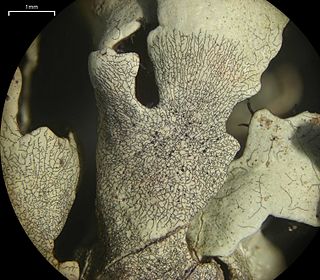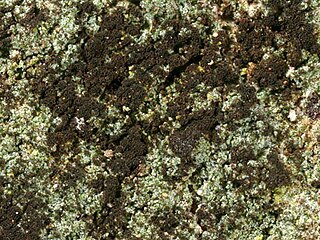
The Arthoniaceae are a family of lichenized, lichenicolous and saprobic fungi in the order Arthoniales. The Arthoniaceae is the largest family of Arthoniales, with around 800 species. Most species in Arthoniaceae belong in Arthonia which is the largest genus with 500 species. The second and third largest genus is Arthothelium with 80 species, and Cryptothecia with 60 species.

Melaspileaceae is a family of lichenized, lichenicolous and saprobic fungi within Ascomycota. These fungi have long been poorly understood, and the family's taxonomic position has been unclear because of insufficient molecular data. It was previously included in the order Arthoniales but recent phylogenetic analyses indicate that it instead belongs to the order Eremithallales.

The Roccellaceae are a family of fungi in the order Arthoniomycetes. Most taxa are lichenized with green algae, although some are lichenicolous, growing on other lichens.
Norrlinia is a genus of two species of fungi in the family Verrucariaceae. The genus was circumscribed by Ferdinand Theissen and Hans Sydow in 1918. The genus name honours the Finnish botanist Johan Petter Norrlin. Both species are lichenicolous, meaning they parasitise lichens. The host of both fungi is the foliose genus Peltigera.
Merismatium is a genus of lichenicolous (lichen-dwelling) fungi of uncertain familial placement in the order Verrucariales. The genus was circumscribed in 1898 by Friedrich Wilhelm Zopf.
Telogalla is a genus of lichenicolous fungi in the family Verrucariaceae. It has two species. The genus was circumscribed by Nikolaus Hoffmann and Josef Hafellner.
Sarcopyrenia is a genus of lichenicolous (lichen-dwelling) fungi. It has 11 species. It is the only genus in Sarcopyreniaceae, a family in the order Verrucariales. Sarcopyrenia was circumscribed by Finnish lichenologist William Nylander in 1858, with Sarcopyrenia gibba assigned as the type species. Sarcopyreniaceae is one of the few families composed entirely of lichenicolous fungi.

Phacopsis is a genus of lichenicolous (lichen-dwelling) fungi. They are parasites of members of the large lichen family Parmeliaceae, of which they are also a member. Originally proposed by Edmond Tulasne in 1852 to contain 3 species, Phacopsis now contains 10 species, although historically, 33 taxa have been described in the genus. Many of the species are poorly known, some of them having been documented only from the type specimen.

Lichenostigma is a genus of fungi. It includes several species which are lichenicolous.
Briancoppinsia is a fungal genus in the family Arthoniaceae. It is monotypic, containing the single species Briancoppinsia cytospora, a lichenicolous fungus that parasitises parmelioid lichens, as well as Cladonia, Lepra, and Lecanora conizaeoides, among others. The species was first described scientifically by Léon Vouaux in 1914 as Phyllosticta cytospora. The genus was circumscribed in 2012 by Paul Diederich, Damien Ertz, James Lawrey, and Pieter van den Boom. The genus was named for Brian John Coppins, who is, according to the authors, an "eminent British lichenologist and expert of lichenicolous fungi".

Opegraphaceae is a family of lichen-forming and lichenicolous fungi in the order Arthoniales. It was originally proposed by German lichenologist Ernst Stizenberger in 1862. It fell into disuse, but was resurrected in a molecular phylogenetic study of the order Arthoniales published in 2010. It now includes taxa that were previously referred to the family Roccellaceae, its sister group.
Lichenosticta is a genus of fungi of uncertain familial placement in the order Lecanorales. It has five species. All species are lichenicolous, meaning they are parasitic on lichens.

Leprocaulaceae is a family of mostly lichen-forming fungi. It is the single family in the monotypic order Leprocaulales. Leprocaulaceae contains three genera and about 33 species.
Rhagadostoma is a genus of fungi in the family Nitschkiaceae. All species in the genus are lichenicolous, meaning they live parasitically on lichens.
James Donald Lawrey is a biologist, specialising in lichens. He is known for leading long-term monitoring projects, taxonomy and studies of the evolution of the fungi in lichens.

Reichlingia is a genus of lichen-forming fungi in the family Arthoniaceae. It has seven species. The genus was originally circumscribed by Paul Diederich and Christoph Scheidegger in 1996, with Reichlingia leopoldii as the type, and at that time, only species. The fungus was at first thought to be a lichenicolous (lichen-dwelling) fungus, but is now considered a lichenised hyphomycete.

Piccolia is a small genus of crustose lichens in the class Lecanoromycetes. First circumscribed by Italian lichenologist Abramo Bartolommeo Massalongo in 1864, it contains ten species. Due to a lack of molecular data, it has not been assigned to an order or family.
Fouragea is a genus of lichen-forming fungi in the family Opegraphaceae. It has nine species.

Fulvophyton is a genus of lichen-forming fungi in the family Roccellographaceae. It has 11 species. Fulvophyton is characterised by its crust-like thallus, which is often pale yellowish-brown in colour. This genus features a photobiont from the green algal genus Trentepohlia and exhibits a unique arrangement of reproductive structures.

Polycoccaceae is a family of lichenicolous (lichen-dwelling) fungi in the order Trypetheliales. The family was circumscribed in 2015 by Damien Ertz, Josef Hafellner, and Paul Diederich. Molecular phylogenetic analysis shows Polycoccaceae to have a sister relationship with the family Trypetheliaceae.











